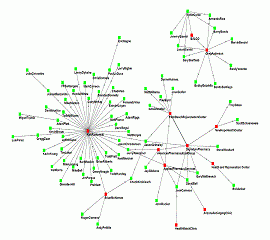I’ve been an active GS1 participant since EPCglobal was first acquired by GS1 in 2003. It is an interesting organization, often both vital and frustrating at the same time. GS1 is a single source for essential supply chain standards that have global applicability. Rather than attempting to dictate those standards they invite people and companies to work with them on the definitions and the application of their standards. They have really great facilitators for some of their work groups with the very best being Mark Frey and Gena Morgan. The quality of their standards documents is quite high. And they have some really smart people in their EPCglobal Architectural Review Committee (ARC), notably Ken Traub, John Williams and Sanjay Sarma.
My hope is that this blog will be of some value to both members and non-members of GS1, but, I can only cover topics related to the organization and their public documents. Specific details about work group activities cannot be covered. However, I do not think that is too limiting and I think members and non-members will find something of interest.
GS1 is a not-for-profit member organization. The way it is organized reminds me of something out of the UN with affiliate “Member Organizations”, or M.O.’s—one for each country in the world—which participate in developing and maintaining their global standards on behalf of end-user companies within their borders. End-user companies are also able to represent themselves … if they can afford the membership fee which is based on company global revenue (and that’s on top of the fees paid for use of your GS1 Company Prefix). Consequently, standards development proceeds mostly with input from employees of GS1 affiliates and from employees of large corporations. There are notable exceptions and GS1 has made a significant effort to recruit participation from hospitals and smaller pharmacies, traditionally under-represented because they are small.
My own experience as one of those employees of an end-user member company, who has participated in standards-making work groups and the end-user groups within GS1 and EPCglobal, has been very positive. I have met and collaborated with a wide range of very smart people from my own industry and others, from the U.S. and from around the globe. I’ve learned a lot about supply chains in general and about how to perform the kind of “techno-negotiations” necessary to move forward a work group of people with very diverse backgrounds and interests toward a positive conclusion. Sometimes it’s thrilling. Sometimes it’s aggravating. It’s always a lot of hard work, but I highly recommend it to anyone considering it.
GS1 also runs “adoption” end-user groups out of their M.O.’s. The purpose of these groups is to encourage the adoption of GS1 standards within the country that the M.O. represents. For example, the GS1 U.S. Member Organization operates the GS1 Healthcare U.S. group which has work groups targeted at accelerating the adoption of GTIN, GLN, GDSN and Traceability the GS1 way in the healthcare sector. These work groups do not work on standards, but they work on guidelines for use in applying those standards to solve various supply chain problems within the U.S. (also known as “toolkits”).
Actual standards have traditionally been developed in two different sub-organizations of GS1: EPCglobal and GSMP (Global Standards Management Process). GS1 is currently in a state of transition as they move the standards development arm of EPCglobal into GSMP. That’s a good thing, because these two organizations have had different approaches and, at times, seemed to operate as two independent organizations. Unfortunately, in my view, EPCglobal’s process operated better than GSMP. So far I am encouraged by the little evidence I have seen that they are retaining the good parts of the EPCglobal approach. We’ll see how far it goes.
One very commendable thing that EPCglobal has done that GSMP has not is to make their ratified standards documents freely available for download on the internet. The GSMP approach is to roll all of their diverse standards into a single and very large document known as the “GS1 General Specification” (or, “GenSpec”) and they’d like to charge you for a copy of it. Fortunately there are enough M.O.’s around the world that make it available that you can usually find a copy for free download by simply Googling it. I hope that the merged GSMP does not fold the individual EPCglobal specifications into the GenSpec and keep them hidden until you pay, but I must admit, even ANSI and ISO charge for their ratified standards documents.
GS1 also has a lobbying arm which applies pressure to governments around the world to adopt policies that are favorable to GS1 and the technologies that their standards are based on. For example, they applied considerable effort to get governments around the world to open up RF frequency bands around 915MHz so that UHF passive RFID tags could operate worldwide without violating the law somewhere. They have been very successful in that effort, as I understand it.
Another example of GS1 lobbying is when they act as technology experts before U.S. state and federal regulatory agencies. Here GS1 provides guidance toward the adoption of regulations and laws that can be met through the use of their standards. I get a little concerned about this type of lobbying because I fear that GS1 makes themselves out to be unbiased when, in fact, they do have a bias. I hope these agencies are aware of that and take it into consideration.
GS1 will be a frequent topic of this blog since they are focused on the same “intersection” as I am (see the tag line for this blog on the masthead).



